Energy Variation Features during the Isothermal Adsorption of Coal under High-Temperature and High-Pressure Conditions
Abstract
:1. Introduction
2. Samples and Experimental Methods
2.1. Sample Collection
2.2. Experimental Methods
3. Experimental Data and Analysis
4. Energy Changes during Isothermal Adsorption Process
4.1. Adsorption Potential and Adsorption Space
4.2. Surface Free Energy
5. Conclusions
Author Contributions
Funding
Data Availability Statement
Conflicts of Interest
References
- Sun, F.R.; Liu, D.M.; Cai, Y.D.; Qiu, Y.K. Coal rank-pressure coupling control mechanism on gas adsorption/desorption in coalbed methane reservoirs. Energy 2023, 270, 126849. [Google Scholar] [CrossRef]
- Jean, R.; Francoise, R.; Philip, L. Adsorption by Powders and Porous Solids: Principles, Methodology and Applications; Academic Press: Pittsburgh, PA, USA, 2013. [Google Scholar]
- Liu, S.S.; Meng, Z.P. Study on energy variation of different coal-body structure coals in the process of isothermal adsorption. J. China Coal Soc. 2015, 40, 1422–1427. [Google Scholar]
- Wu, S.; Tang, D.Z.; Li, S.; Chen, H.; Wu, H.Y. Coalbed methane adsorption behavior and its energy variation features under supercritical pressure and temperature conditions. J. Pet. Sci. Eng. 2016, 146, 726–734. [Google Scholar] [CrossRef]
- Guo, H.J.; Cheng, Y.P.; Wang, L.; Lu, S.Q.; Jin, K. Experimental study on the effect of moisture on low-rank coal adsorption characteristics. J. Nat. Gas Sci. Eng. 2015, 24, 245–251. [Google Scholar] [CrossRef]
- Jiang, W.P.; Cui, Y.J.; Zhang, Q.; Zhong, L.W.; Li, Y.H. The quantum chemical study on different rank coals surface interacting with methane. J. China Coal Soc. 2007, 32, 292–295. [Google Scholar]
- Li, H.J.; Wang, S.C.; Zeng, Q.; Kang, J.H.; Guan, W.M.; Li, W.T. Effects of Pore Structure of Different Rank Coals on Methane Adsorption Heat. Processes 2021, 9, 1971. [Google Scholar] [CrossRef]
- Nie, B.S.; He, X.Q.; Wang, E.Y. Surface free energy of coal and its calculation. J. Taiyuan Univ. Technol. 2000, 31, 346–348. [Google Scholar]
- Li, X.J.; Lin, B.Q.; Xu, H. Monte Carlo simulation of methane molecule adsorption on coal with adsorption potential. Int. J. Min. Sci. Technol. 2014, 24, 17–22. [Google Scholar] [CrossRef]
- Xie, J.; Liang, Y.P.; Zou, Q.L.; Wang, Z.H.; Li, X.L. Prediction Model for Isothermal Adsorption Curves Based on Adsorption Potential Theory and Adsorption Behaviors of Methane on Granular Coal. Energy Fuels 2019, 33, 1910–1921. [Google Scholar] [CrossRef]
- Li, S.; Tang, D.Z.; Pan, Z.J.; Xu, H.; Guo, L.L. Evaluation of coalbed methane potential of different reservoirs in western Guizhou and eastern Yunnan, China. Fuel 2015, 139, 257–267. [Google Scholar] [CrossRef]
- Ji, L.M.; Zhang, T.W.; Milliken, K.L.; Qu, J.L.; Zhang, X.L. Experimental investigation of main controls to methane adsorption in clay-rich rocks. Appl. Geochem. 2012, 27, 2533–2545. [Google Scholar] [CrossRef]
- Baran, P.; Zarebska, K.; Bukowska, M. Expansion of Hard Coal Accompanying the Sorption of Methane and Carbon Dioxide in Isothermal and Non-isothermal Processes. Energy Fuels 2015, 29, 1899–1904. [Google Scholar] [CrossRef]
- Shen, J.; Zhang, C.J.; Qin, Y.; Zhang, B. Effect factors on comining of sandstone gas and coalbed methane in coal series and threshold of parameter in Linxing block, Ordos Basin. Nat. Gas Geosci. 2017, 28, 479–487. [Google Scholar]
- Xie, Y.G.; Meng, S.Z.; Gao, L.J.; Zhang, X.Y.; Duan, C.J.; Wang, H.P. Assessments on potential resources of deep coal bed methane and compact sandstone has in Linxin Area. Coal Sci. Technol. 2015, 43, 21–24+28. [Google Scholar]
- Tao, C.Q.; Wang, Y.B.; Ni, X.M.; Wu, X. Key accumulation period for coal series gas reservoir in upper carboniferous Benxi Formation, Linxing block. J. China Univ. Min. Technol. 2018, 47, 531–537. [Google Scholar]
- GB/T 6948-2008; Method of Determining Microscopically the Reflectance of Vitrinite in Coal. Standardization Administration of the People’s Republic of China: Beijing, China, 2008.
- GB/T212-2008; Proximate Analysis of Coal. Standardization Administration of the People’s Republic of China: Beijing, China, 2008.
- Chen, S.D.; Tao, S.; Tang, D.Z.; Xu, H.; Li, S.; Zhao, J.J.; Jiang, Q.; Yang, H.X. Pore Structure Characterization of Different Rank Coals Using N2 and CO2 Adsorption and Its Effect on CH4 Adsorption Capacity: A Case in Panguan Syncline, Western Guizhou, China. Energy Fuels 2017, 31, 6034–6044. [Google Scholar] [CrossRef]
- Long, H.; Lin, H.F.; Yan, M.; Chang, P.; Li, S.G.; Bai, Y. Molecular simulation of the competitive adsorption characteristics of CH4, CO2, N2, and multicomponent gases in coal. Powder Technol. 2021, 385, 348–356. [Google Scholar] [CrossRef]
- Shen, J.; Qin, Y.; Fu, X.H.; Chen, G.; Chen, R. Properties of Deep Coalbed Methane Reservoir-forming Conditions and Critical Depth Discussion. Nat. Gas Geosci. 2014, 25, 1470–1476. [Google Scholar]
- Moore, T.A. Coalbed methane: A review. Int. J. Coal Geol. 2012, 101, 36–81. [Google Scholar] [CrossRef]
- Qin, Y.; Moore, T.A.; Shen, J.; Yang, Z.B.; Shen, Y.L.; Wang, G. Resources and geology of coalbed methane in China: A review. Int. Geol. Rev. 2018, 60, 777–812. [Google Scholar] [CrossRef]
- Polanyi, M. The potential theory of adsorption. Science 1963, 141, 1010–1013. [Google Scholar] [CrossRef] [PubMed]
- Amankwah, K.A.G.; Schwarz, J.A. A modified approach for estimating pseudovapor pressure in the application of the Dubinin-Astakhov equation. Carbon 1995, 33, 1313–1319. [Google Scholar] [CrossRef]
- Mosher, K.; He, J.J.; Liu, Y.Y.; Rupp, E.; Wilcox, J. Molecular simulation of methane adsorption in micro- and mesoporous carbons with applications to coal and gas shale systems. Int. J. Coal Geol. 2013, 109–110, 36–44. [Google Scholar] [CrossRef]
- Perez, F.; Devegowda, D. Estimation of adsorbed-phase density of methane in realistic overmature kerogen models using molecular simulations for accurate gas in place calculations. J. Nat. Gas Sci. Eng. 2017, 46, 865–872. [Google Scholar] [CrossRef]
- Ozawa, W.; Kusumi, S.; Ogino, Y.J. Physical adsorption of gases at high pressure. Ⅳ. An improvement of the Dubinin-Astakhov adsorption equation. J. Colloid Interface Sci. 1976, 56, 83–91. [Google Scholar] [CrossRef]
- Li, Q.Z.; Lin, B.Q.; Wang, K.; Zhao, M.Z.; Ruan, M.L. Surface properties of pulverized coal and its effects on coal mine methane adsorption behaviors under ambient conditions. Powder Technol. 2015, 270, 278–286. [Google Scholar] [CrossRef]
- Yang, Z.B.; Qin, Y.; Gao, D.; Chen, R. Differences between apparent and true adsorption quantity of coalbed methane under supercritical conditions and their geological significance. Nat. Gas Ind. 2011, 31, 13–16+122. [Google Scholar]
- Lu, S.Q.; Wang, L.; Qin, L.M. Analysis on Adsorption Capacity and Adsorption Thermodynamic Characteristics of different Metamorphic Degree Coals. Coal Sci. Technol. 2014, 42, 130–135. [Google Scholar]
- Meng, Z.P.; Liu, S.S.; Li, G.Q. Adsorption capacity, adsorption potential and surface free energy of different structure high rank coals. J. Pet. Sci. Eng. 2016, 146, 856–865. [Google Scholar] [CrossRef]
- Wang, Z.Z.; Fu, X.H.; Pan, J.N.; Deng, Z. Effect of N2/CO2 injection and alternate injection on volume swelling/shrinkage strain of coal. Energy 2023, 275, 127377. [Google Scholar] [CrossRef]
- Zou, W.J.; Cao, Y.J.; Sun, C.B. Adsorption of anionic polyacrylamide onto coal and kaolinite: Changes of surface free energy components. Part. Sci. Technol. 2017, 35, 233–238. [Google Scholar] [CrossRef]
- Tao, C.Q.; Wang, Y.B.; Li, Y.; Ni, X.M.; Gao, X.D. Adsorption Mechanism and Kinetic Characterization of Bituminous Coal under High Temperatures and Pressures in the Linxing-Shenfu Area. Acta Geol. Sin. 2020, 94, 399–408. [Google Scholar] [CrossRef]
- Du, X.D.; Cheng, Y.G.; Liu, Z.J.; Yin, H.; Wu, T.F.; Huo, L.; Shu, C.X. CO2 and CH4 adsorption on different rank coals: A thermodynamics study of surface potential, Gibbs free energy change and entropy loss. Fuel 2021, 283, 11886. [Google Scholar] [CrossRef]
- Wang, Z.Z.; Fu, X.H.; Hao, M.; Li, G.F.; Pan, J.N.; Niu, Q.H.; Zhou, H. Experimental insights into the adsorption-desorption of CH4/N2 and induced strain for medium-rank coals. J. Pet. Sci. Eng. 2021, 204, 108705. [Google Scholar] [CrossRef]
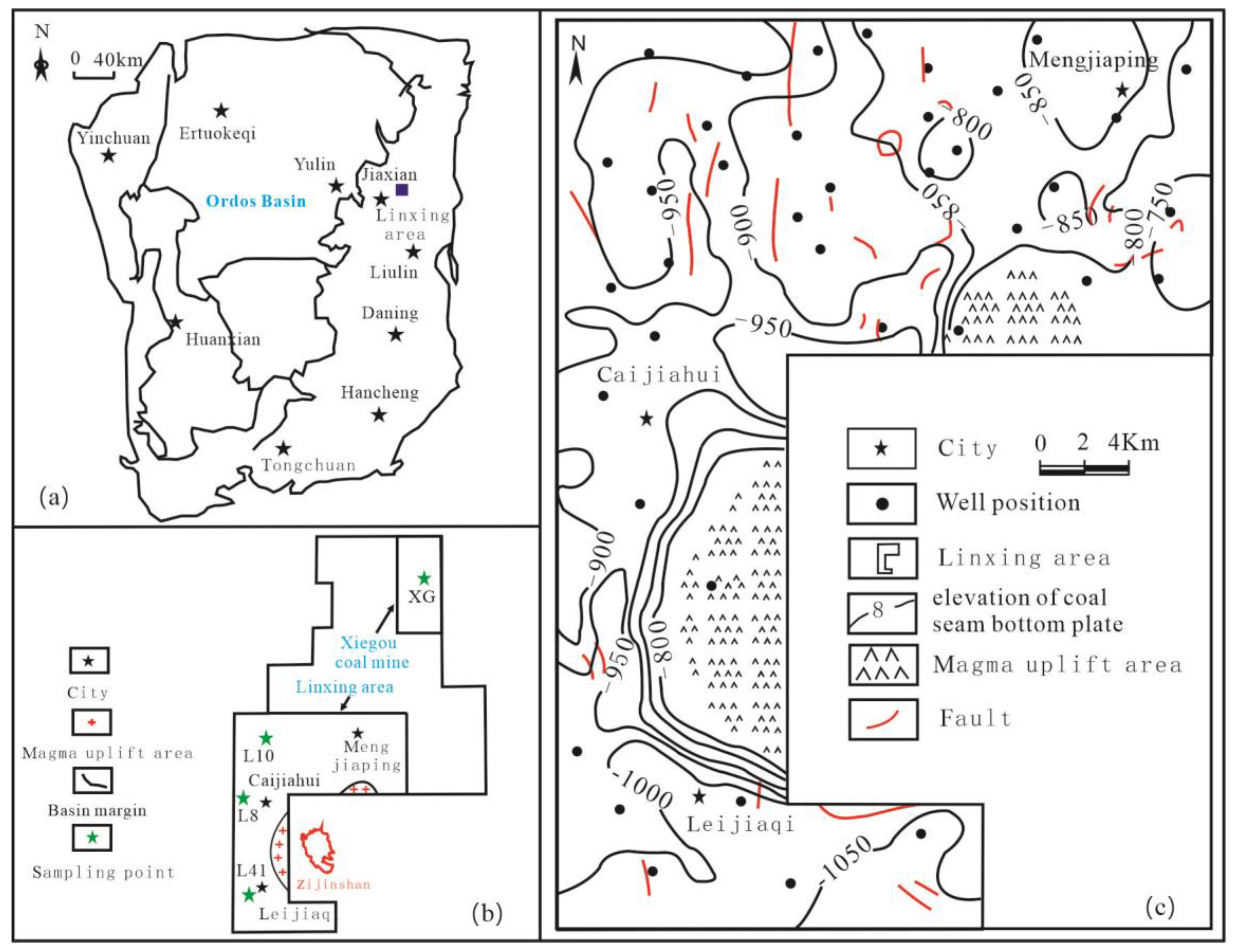

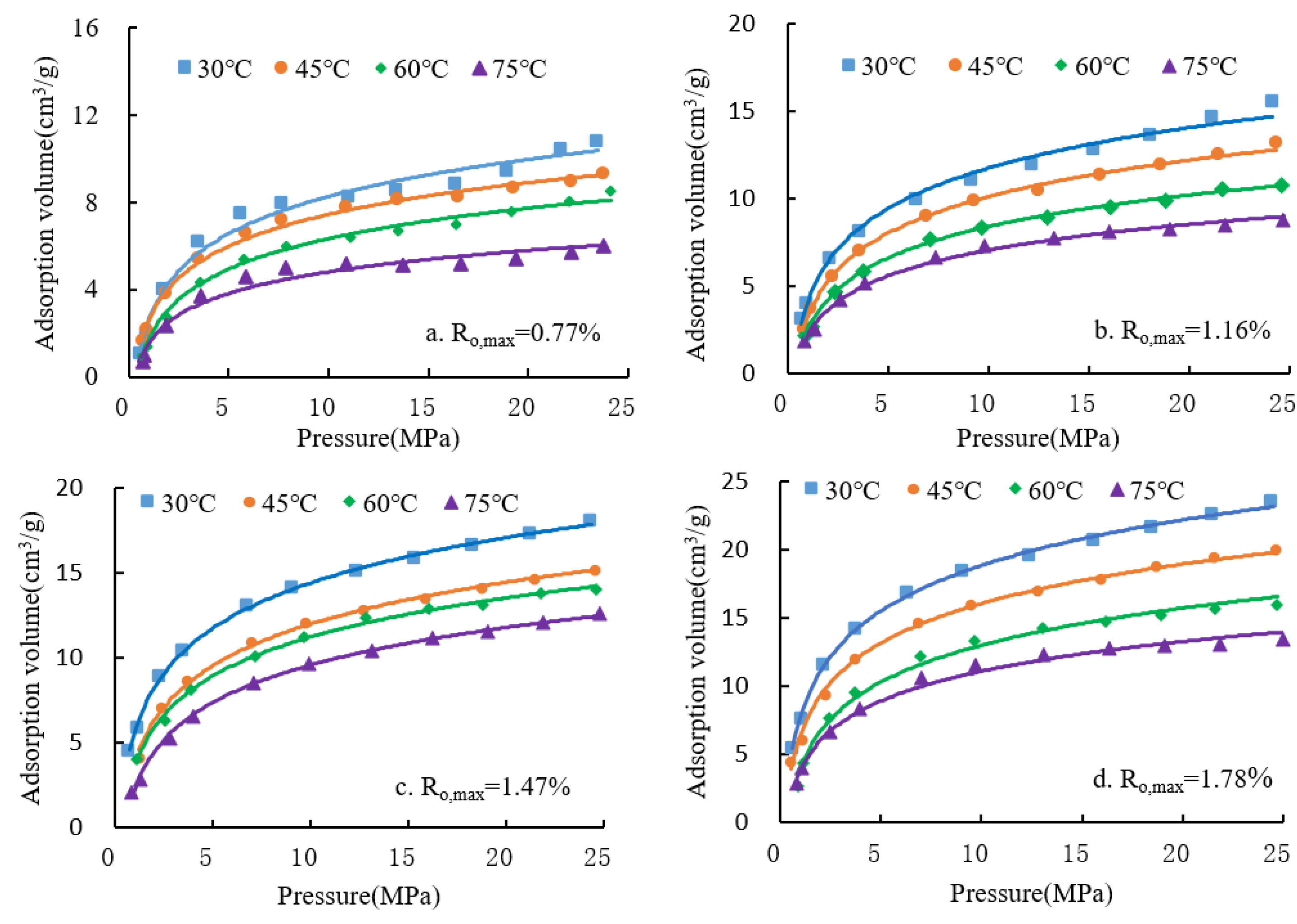

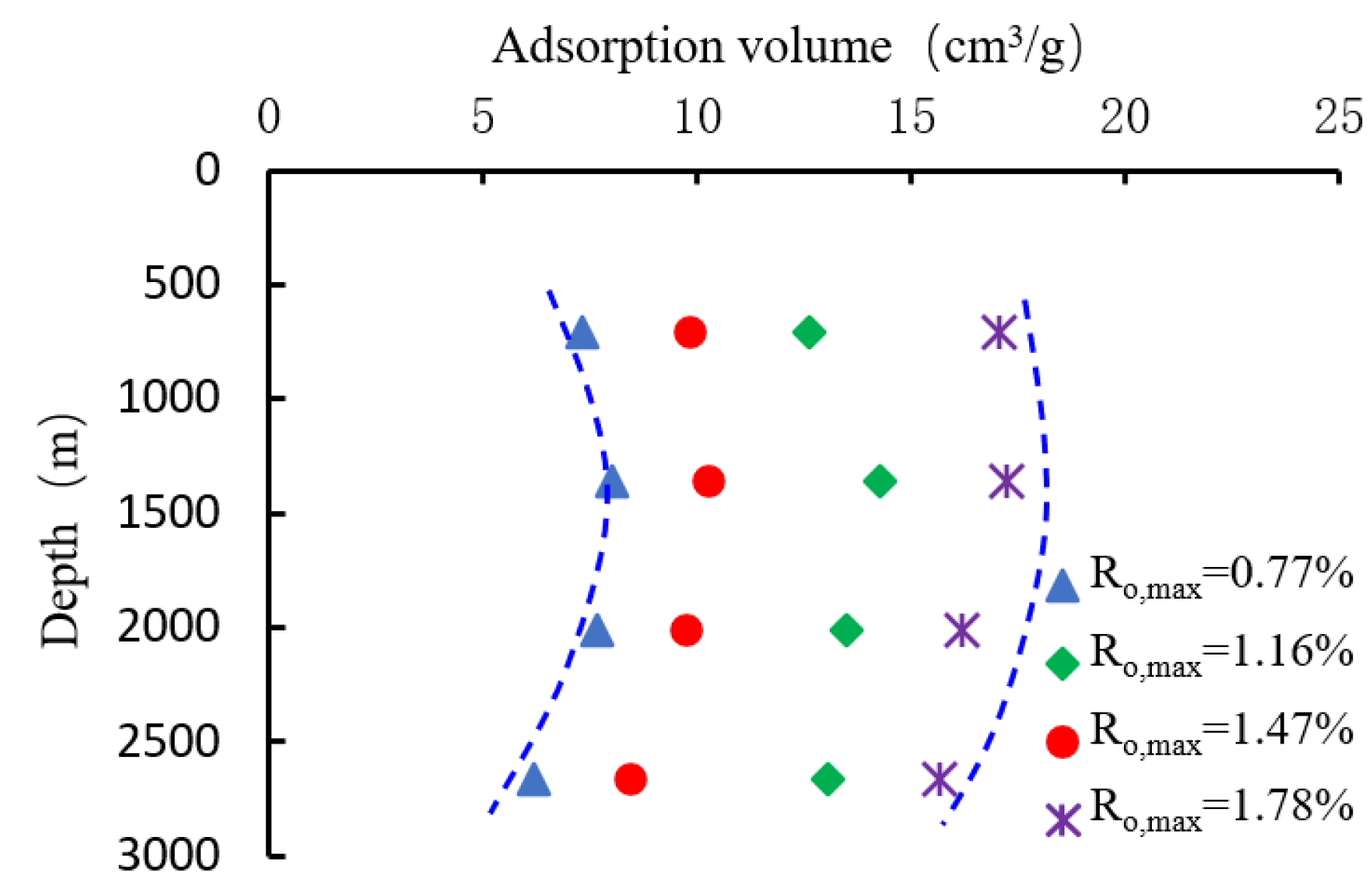

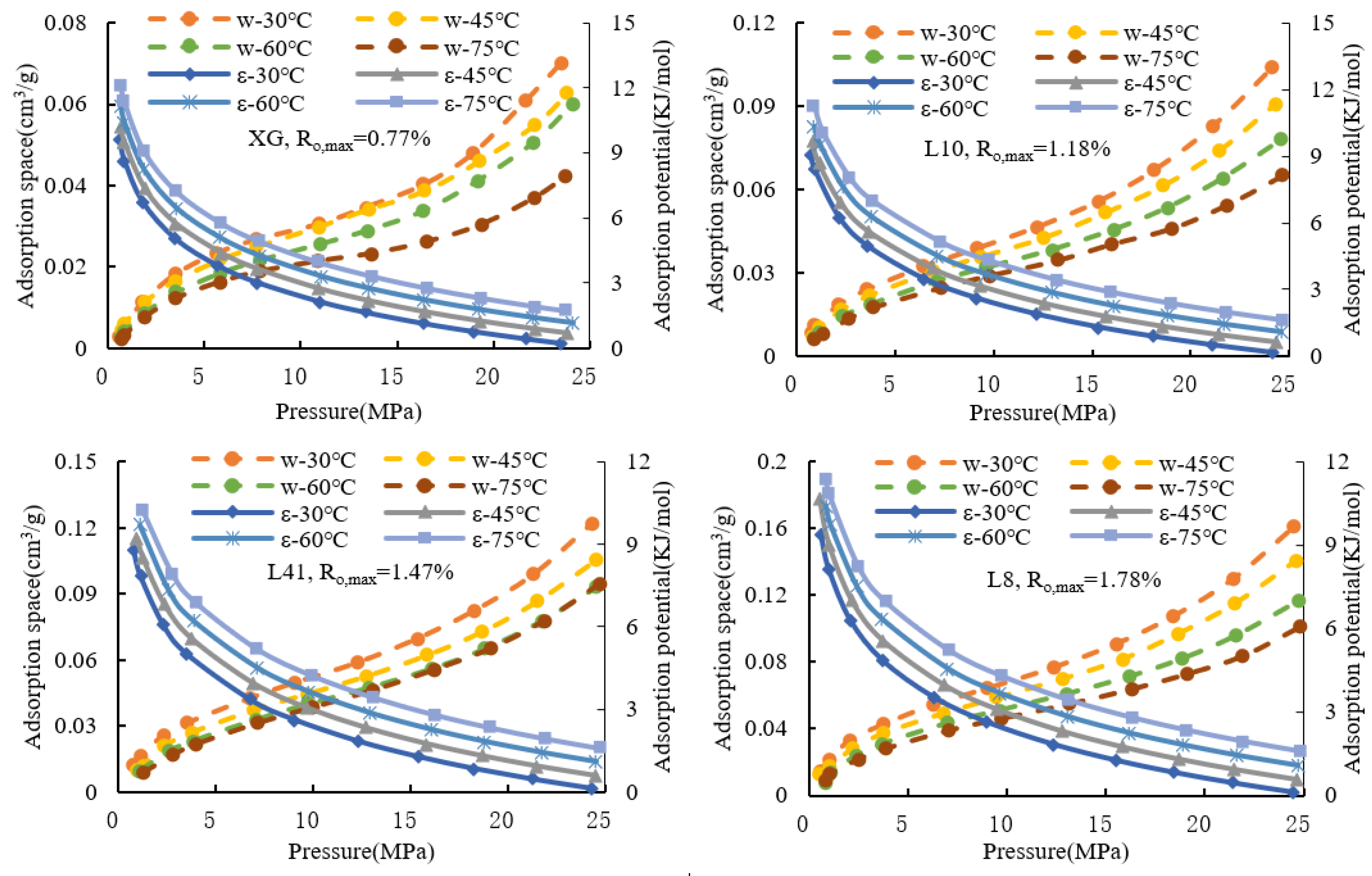
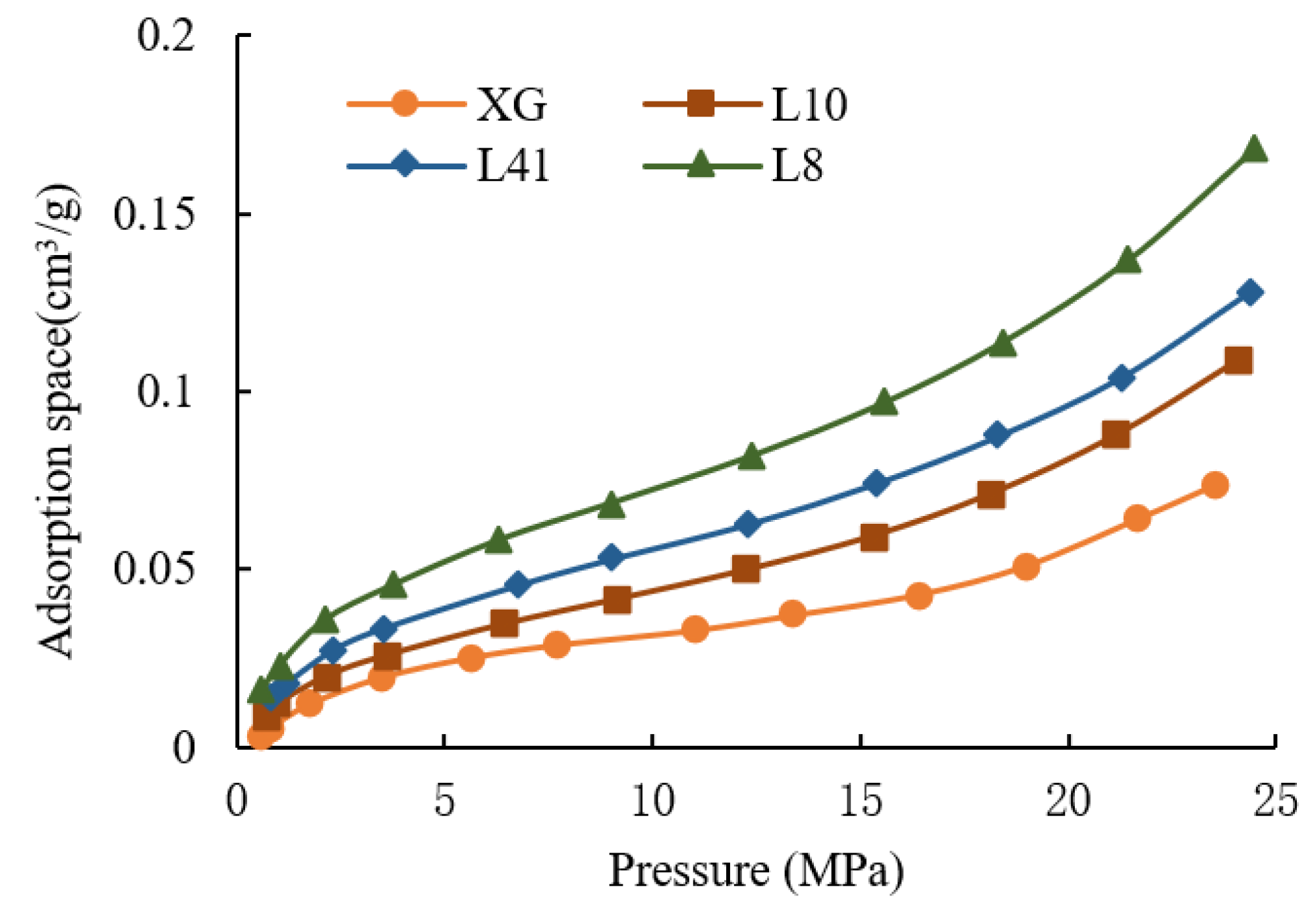

| Sample Information | Maceral Composition | Proximate Analysis | Pore Specific Surface Area | |||||||
|---|---|---|---|---|---|---|---|---|---|---|
| Sample Numbers | Depth (m) | Ro,max (%) | Coal Rank | Vitrinite (%) | Inertinite (%) | Moisture (%) | Ash (%) | Valitile (%) | N2 (m2/g) | CO2 (m2/g) |
| XG | 450.0 | 0.77 | gas coal | 78.32 | 7.86 | 2.41 | 10.50 | 35.12 | 0.26 | 44.90 |
| L10 | 1636.6 | 1.16 | fat coal | 76.45 | 8.50 | 0.95 | 11.12 | 26.85 | 0.27 | 54.62 |
| L41 | 2158.0 | 1.47 | coking coal | 85.20 | 10.20 | 1.12 | 7.85 | 20.24 | 0.60 | 65.90 |
| L8 | 1888.0 | 1.78 | thin coal | 82.42 | 5.40 | 0.63 | 14.64 | 12.66 | 0.89 | 72.31 |
Disclaimer/Publisher’s Note: The statements, opinions and data contained in all publications are solely those of the individual author(s) and contributor(s) and not of MDPI and/or the editor(s). MDPI and/or the editor(s) disclaim responsibility for any injury to people or property resulting from any ideas, methods, instructions or products referred to in the content. |
© 2023 by the authors. Licensee MDPI, Basel, Switzerland. This article is an open access article distributed under the terms and conditions of the Creative Commons Attribution (CC BY) license (https://creativecommons.org/licenses/by/4.0/).
Share and Cite
Jing, T.; Tao, C.; Wang, Y.; Miao, H.; Xi, M.; Zhao, X.; Fu, H. Energy Variation Features during the Isothermal Adsorption of Coal under High-Temperature and High-Pressure Conditions. Processes 2023, 11, 2524. https://doi.org/10.3390/pr11092524
Jing T, Tao C, Wang Y, Miao H, Xi M, Zhao X, Fu H. Energy Variation Features during the Isothermal Adsorption of Coal under High-Temperature and High-Pressure Conditions. Processes. 2023; 11(9):2524. https://doi.org/10.3390/pr11092524
Chicago/Turabian StyleJing, Tongling, Chuanqi Tao, Yanbin Wang, Huan Miao, Mingyu Xi, Xingchen Zhao, and Haiyang Fu. 2023. "Energy Variation Features during the Isothermal Adsorption of Coal under High-Temperature and High-Pressure Conditions" Processes 11, no. 9: 2524. https://doi.org/10.3390/pr11092524






